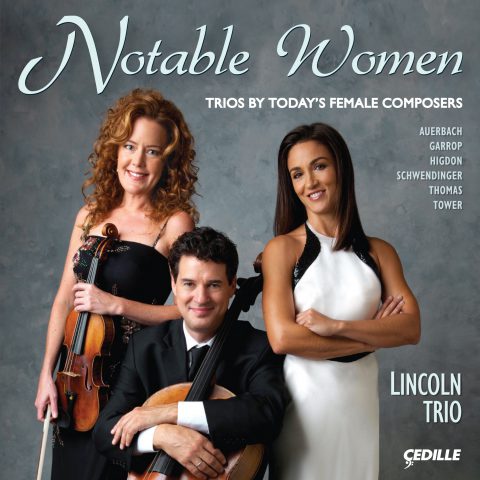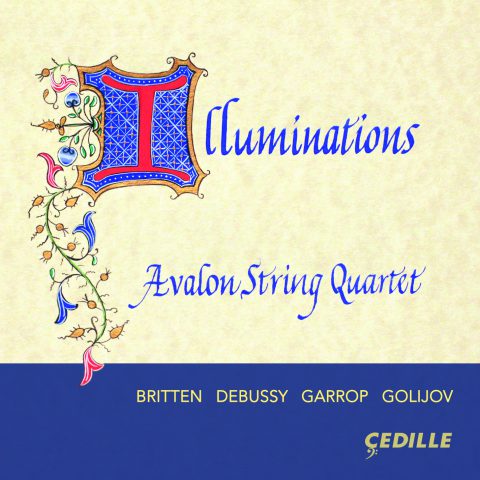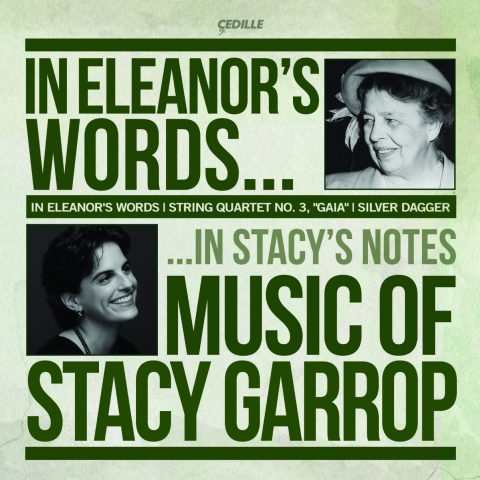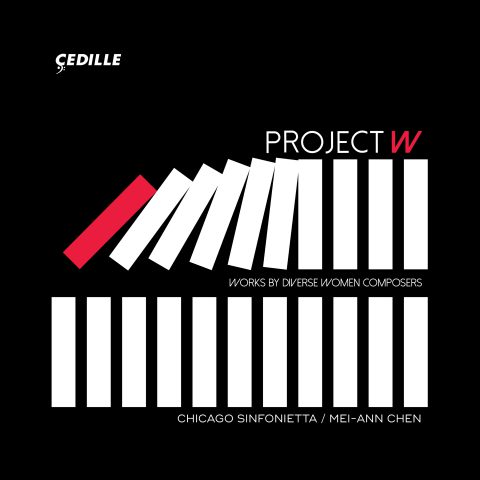Store
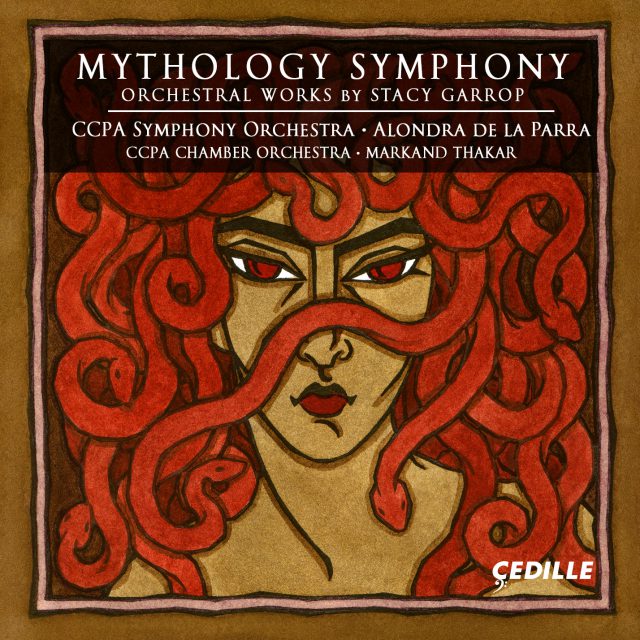
Store
Mythology Symphony: Orchestral Works by Stacy Garrop
Chicago College of Performing Arts Orchestras
Alondra de la Parra, Markand Thakar, Stacy Garrop
Flourishing American composer Stacy Garrop’s first album of orchestral music features the world-premiere recording of her Mythology Symphony, a five-movement work inspired by famous female figures from Greek mythology. Characterized by Garrop’s talent for lyricism and vivid storytelling, the symphony receives a typically vibrant and compelling performance by Billboard-charting international conductor Alonda de la Parra leading the Chicago College of Performing Arts (CCPA) Symphony Orchestra of Roosevelt University. Under the direction of Peabody Conservatory-based conductor Markand Thakar, the CCPA Chamber Orchestra delivers world-premiere recordings of Garrop’s mythic Thunderwalker and Shadow, a moving interplay of counterpoint, shifting textures, and profound emotion. Mythology Symphony, composed from 2007 to 2013, is the product of commissions from the Detroit and Albany Symphony Orchestras, and Chicago’s Roosevelt University, where Garrop is associate professor of composition.
Garrop’s music “excites the enthusiasm of performers and audiences alike” (Pittsburgh Tribune-Review). She has “a sharp ear for instrumental color and narrative form: She can tell a story” (Detroit Free Press). Gramophone calls her a composer whose work displays “vision and breadth.” The Journal of the International Association of Women in Music proclaims, “Without question, Garrop is poised to make significant and lasting contributions to [the] world of classical music.”
Fall 2015 is a high-profile season for Garrop: her oratorio Terra Nostra will receive its world premiere November 14–15 in San Francisco. The world-premiere recording of her String Quartet No. 4: Illuminations, was recently released by Cedille Records, in a performance by the Avalon String Quartet. Her Flight of Icarus for saxophones appears on a new CD from the Capital Quartet on the Blue Griffin label. The celebrated male choir Chanticleer included one of her pieces in its 2014—2015 tour program and on a live-in-concert recording.
Preview Excerpts
Mythology Symphony
Thunderwalker
Shadow
Artists
1: CCPA Symphony, Alondra de la Parra
2: CCPA Symphony, Alondra de la Parra
3: CCPA Symphony, Alondra de la Parra
4: CCPA Symphony, Alondra de la Parra
5: CCPA Symphony, Alondra de la Parra
6: CCPA Chamber Orchestra, Markand Thakar
7: CCPA Chamber Orchestra, Markand Thakar
8: CCPA Chamber Orchestra, Markand Thakar
9: CCPA Chamber Orchestra, Markand Thakar
Program Notes
Download Album BookletMythology Symphony: Orchestral Works by Stacy Garrop
Notes by Stacy Garrop
The works on this CD comprise my major orchestral output from 1999 to 2013. I wrote Thunderwalker, the earliest of the three works, in 1999 as my doctoral dissertation. Shadow followed two years later when the Chicago College of Performing Arts Chamber Orchestra of Roosevelt University went on tour to Japan; as a new faculty member, I was invited to write a piece for the occasion. Mythology Symphony is the most recent work, written over a six-year period. Although these three works were composed over a 14-year span, they share several inherent traits: a strong sense of drama, a lyrical language, and overarching stories that govern the formal structures of each work.
Mythology Symphony
I wrote the Mythology Symphony progressively over several years. It started with a 2007 Detroit Symphony commission for Becoming Medusa. The Albany Symphony followed in 2009 with commissions for The Lovely Sirens and The Fates of Man. The Symphony was completed when the Chicago College of Performing Arts commissioned Penelope Waits and Pandora Undone. The complete Symphony received its world premiere in January 2015 by the Chicago College of Performing Arts Orchestra conducted by Alondra de la Parra.
I. Becoming Medusa
Most of us are familiar with the legend of Medusa as a hideous Gorgon with scales for skin, snakes for hair, and a gaze that turns to stone anyone who dares look into her eyes. Our first encounter of Medusa usually finds her on a deserted island with her two sisters just as Perseus arrives to cut off Medusa’s head. But what about Medusa’s origins? With some research, I unearthed several accounts of her original form. Several stories portray Medusa as a strikingly beautiful woman whose features were hideously transformed by the goddess Athena after she made the poor decision to seduce the god Poseidon in Athena’s temple. For its great dramatic appeal, it is this story of Medusa that I chose to set to music.
Musically, Medusa is represented by a solo violin. When she first appears as a lovely woman (following a dissonant introduction indicating her final state), she is accompanied by harp, and her music is very lyrical. After Medusa is transformed, dissonance surrounds her: strings, woodwinds, and percussion represent the snakes on her head as they twist and turn around each other, while her piercing eyes are depicted by the discordant interval of a minor second. In between, we hear her sultry seduction of Poseidon and Athena’s furious reaction. The movement’s title has a double meaning. It suggests both Medusa’s original loveliness and her transformation. In addition to its common use to indicate a process of change, the word “becoming” also means “attractive.”
II. Penelope Waits
This quiet movement represents Queen Penelope, the faithful wife of Odysseus, as she patiently waits twenty years for her husband’s return from fighting the Trojan Wars. Penelope herself is represented as an oboe. She is accompanied by a chamber orchestra (rather than the entire ensemble) as she keeps at bay the suitors who wish to marry her and inherit her riches.
III. The Lovely Sirens
The Sirens were sea nymphs, usually pictured as part woman and part bird, who lived on a secluded island surrounded by rocks. Their enchanting song was irresistible to passing sailors, who were lured to their deaths as their ships were destroyed upon the rocks. The Lovely Sirens presents three ideas: the Sirens’ beautiful song, an unfortunate group of sailors whose course takes them near the island, and the disaster that befalls the sailors. The sailors’ peril is represented by the Morse code S.O.S. signal (three dots, three dashes, and three dots—represented musically by short and long rhythms). The S.O.S. signal grows increasingly more insistent and distressed as it becomes obvious that the sailors, smitten with the voices of the Sirens, are headed for their demise.
IV. The Fates of Man
The three Sisters of Fate were minor goddesses who served as personifications of man’s inescapable destiny. Each Sister had a particular task: Klotho spun the thread of life; Lakhesis measured the thread; and Atropos cut the thread. While a man’s actions affected various aspects of his life, the length of his mortality was predetermined. The Fates of Man portrays a man who realizes he is nearing the end of his life. He appeals to the three Sisters to give him control over his own destiny, but as they have already measured and cut his thread, they deny his request. The movement ends with the man slowly dying away.
V. Pandora Undone
This movement is, in turns, both lighthearted and serious. The music depicts a young, naïve Pandora who, while dancing around her house, spies a mysterious box. She tries to resist opening it, but her curiosity ultimately gets the best of her. When she cracks the lid open and looks inside, all evils escape into the world. Dismayed by what she has done, she looks inside the box once more. She discovers hope still in the box and releases it to temper the escaped evils and assuage mankind’s new burden.
Thunderwalker
Thunderwalker is built on two overlapping structures. The first encompasses the form of each movement: the first movement is a fugue, the second a ground bass (passacaglia), the third a scherzo-trio. The second derives from what the title suggested to me. I see a thunderwalker as a huge, god-like figure who lives in the sky and whose footsteps fall loudly among the clouds. If I were a member of a pre-modern earth society and wanted to get the god-like figure’s attention, I would go through a ritual cleansing ceremony (movement 1), then invoke him over and over again (movement 2) until I had successfully summoned him (movement 3). The two structures complement each other: a fugue is a ritual of sorts: it follows a strict set of procedures, much like what one might do in a cleansing ceremony. Passacaglias, by their very nature, repeat themselves endlessly, like one lost in chanting invocations. This particular passacaglia is interrupted after each repetitive cycle by chaotic, grumbling noises, suggesting the god awakening in the skies. The character of a scherzo-trio can range from light and quick to sinister or macabre. I imagine that if a god were summoned down to earth, he would appear good to some and sinister to others, and he would move swiftly about the earth’s surface.
The entire work is spun from the opening fugue motive. The first movement focuses on developing the fugue materials, particularly a minor third–tritone interval pattern. The second movement takes a nine-note pitch pattern that was introduced in the first movement — a repeating interval pattern of two minor seconds followed by a major second — and turns it into a nine-chord pattern (each statement of this pattern equals one complete cycle of the passacaglia). Finally, the third movement mutates the nine-note pitch pattern into an eight-note pattern of alternating minor and major seconds known as the octatonic scale.
Shadow
Shadow is a chronicle of my stay at the Yaddo artist colony in New York in summer 2001. Upon arriving, I met several visual artists and photographers whose work sparked my imagination. One artist used ordinary safety pins to create wall hangings and tree snakes; a painter studied a scene of nature and then painted it from memory so the final painting would contain bright blues, pinks, and greens not in Nature’s original. Since I wanted to explore ways to break out of my current composing methods, I spent time taking photographs of particular items — a statue’s reflection in the ripples of a fountain and small parts of stained glass window — to shift my mind into new directions. When pieced together on my studio wall, these pictures formed a collage of jagged bits of color and motion. To me, these suggested overlapping lines of counterpoint, shifting textures, and intersecting blocks of music. I also felt the need to write the piece out of order; parts of the piece got developed for a month or two, then a part that comes earlier would be worked out, then I would skip ahead to what I thought would be the end, and then go back to parts already developed to pull the music further along.
The title is derived from a Yaddo story. Over a century ago, the Trask family bought the property that would later become Yaddo. When Mrs. Trask asked her four-year-old daughter what they should name the place, she replied Yaddo, because it rhymes with shadow. To the little girl, the word shadow represented death. Death constantly surrounded the Trask family, who ultimately lost all four children during their infancy or early childhood. As death surrounds us in unexpected ways throughout our lives, I could not escape learning of an old friend’s demise while at Yaddo. This experience shaded what I had originally planned to be a light, colorful work into something much darker.
Album Details
Total Time: 61:25
Producer: James Ginsburg
Engineer: Bill Maylone
Recorded: March 5–7, 2014, January 29–30, 2015, Benito Juarez Community Academy Auditorium, Chicago, Illinois
Graphic Design: Nancy Bieschke
Cover Art: Medusa, Thalia Took
© 2015 Cedille Records/Cedille Chicago
CDR 90000 160
